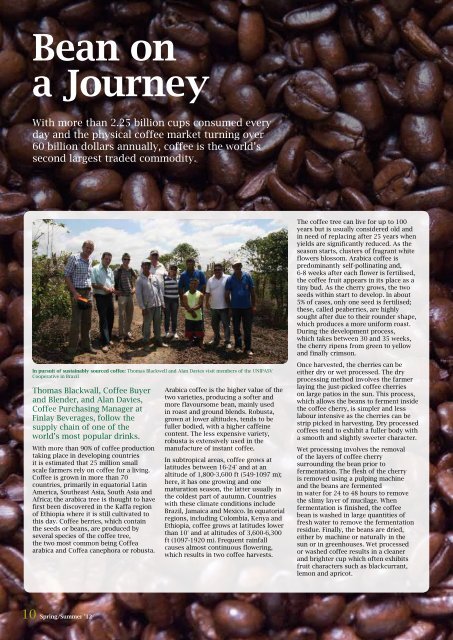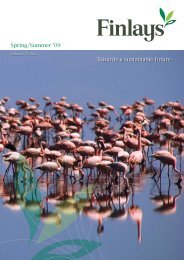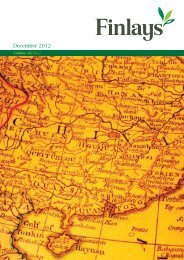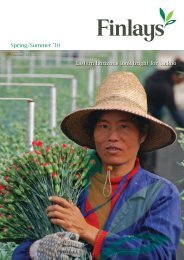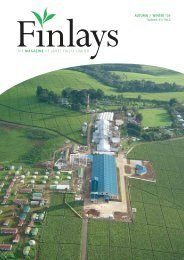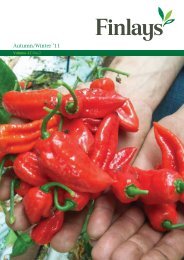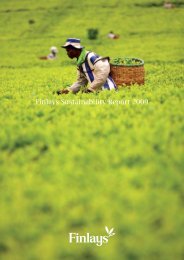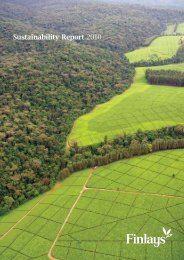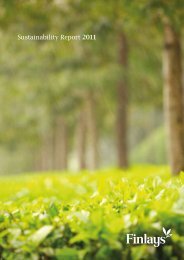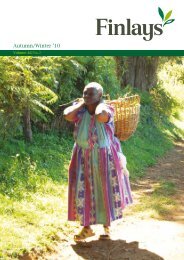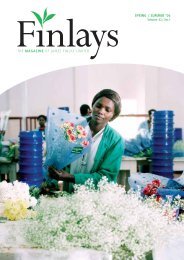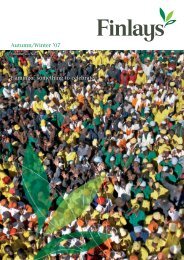Create successful ePaper yourself
Turn your PDF publications into a flip-book with our unique Google optimized e-Paper software.
Bean on<br />
a Journey<br />
With more than 2.25 billion cups consumed every<br />
day and the physical coffee market turning over<br />
60 billion dollars annually, coffee is the world’s<br />
second largest traded commodity.<br />
In pursuit of sustainably sourced coffee: Thomas Blackwell and Alan Davies visit members of the UNIPASV<br />
Cooperative in Brazil<br />
Thomas Blackwall, Coffee Buyer<br />
and Blender, and Alan Davies,<br />
Coffee Purchasing Manager at<br />
Finlay Beverages, follow the<br />
supply chain of one of the<br />
world’s most popular drinks.<br />
With more than 90% of coffee production<br />
taking place in developing countries<br />
it is estimated that 25 million small<br />
scale farmers rely on coffee for a living.<br />
Coffee is grown in more than 70<br />
countries, primarily in equatorial Latin<br />
America, Southeast Asia, South Asia and<br />
Africa; the arabica tree is thought to have<br />
first been discovered in the Kaffa region<br />
of Ethiopia where it is still cultivated to<br />
this day. Coffee berries, which contain<br />
the seeds or beans, are produced by<br />
several species of the coffee tree,<br />
the two most common being Coffea<br />
arabica and Coffea canephora or robusta.<br />
10 <strong>Spring</strong>/<strong>Summer</strong> ’12<br />
Arabica coffee is the higher value of the<br />
two varieties, producing a softer and<br />
more flavoursome bean, mainly used<br />
in roast and ground blends. Robusta,<br />
grown at lower altitudes, tends to be<br />
fuller bodied, with a higher caffeine<br />
content. The less expensive variety,<br />
robusta is extensively used in the<br />
manufacture of instant coffee.<br />
In subtropical areas, coffee grows at<br />
latitudes between 16-24° and at an<br />
altitude of 1,800-3,600 ft (549-1097 m);<br />
here, it has one growing and one<br />
maturation season, the latter usually in<br />
the coldest part of autumn. Countries<br />
with these climate conditions include<br />
Brazil, Jamaica and Mexico. In equatorial<br />
regions, including Colombia, Kenya and<br />
Ethiopia, coffee grows at latitudes lower<br />
than 10° and at altitudes of 3,600-6,300<br />
ft (1097-1920 m). Frequent rainfall<br />
causes almost continuous flowering,<br />
which results in two coffee harvests.<br />
The coffee tree can live for up to 100<br />
years but is usually considered old and<br />
in need of replacing after 25 years when<br />
yields are significantly reduced. As the<br />
season starts, clusters of fragrant white<br />
flowers blossom. Arabica coffee is<br />
predominantly self-pollinating and,<br />
6-8 weeks after each flower is fertilised,<br />
the coffee fruit appears in its place as a<br />
tiny bud. As the cherry grows, the two<br />
seeds within start to develop. In about<br />
5% of cases, only one seed is fertilised;<br />
these, called peaberries, are highly<br />
sought after due to their rounder shape,<br />
which produces a more uniform roast.<br />
During the development process,<br />
which takes between 30 and 35 weeks,<br />
the cherry ripens from green to yellow<br />
and finally crimson.<br />
Once harvested, the cherries can be<br />
either dry or wet processed. The dry<br />
processing method involves the farmer<br />
laying the just-picked coffee cherries<br />
on large patios in the sun. This process,<br />
which allows the beans to ferment inside<br />
the coffee cherry, is simpler and less<br />
labour intensive as the cherries can be<br />
strip picked in harvesting. Dry processed<br />
coffees tend to exhibit a fuller body with<br />
a smooth and slightly sweeter character.<br />
Wet processing involves the removal<br />
of the layers of coffee cherry<br />
surrounding the bean prior to<br />
fermentation. The flesh of the cherry<br />
is removed using a pulping machine<br />
and the beans are fermented<br />
in water for 24 to <strong>48</strong> hours to remove<br />
the slimy layer of mucilage. When<br />
fermentation is finished, the coffee<br />
bean is washed in large quantities of<br />
fresh water to remove the fermentation<br />
residue. Finally, the beans are dried,<br />
either by machine or naturally in the<br />
sun or in greenhouses. Wet processed<br />
or washed coffee results in a cleaner<br />
and brighter cup which often exhibits<br />
fruit characters such as blackcurrant,<br />
lemon and apricot.<br />
Bean on a Journey<br />
Thomas Blackwell and Alan Davies<br />
Building relationships with our suppliers: the Beverages<br />
team with Dos Costas Cooperative in Brazil.<br />
When export is imminent the coffee<br />
is taken to the mill where either the<br />
parchment or the dried coffee cherry<br />
is removed, depending on which process<br />
is used. Due to its size, the milling plant<br />
is normally owned by the cooperative<br />
which buys the coffee from the farmer<br />
and prepares it for export. Following the<br />
hulling, the beans are sorted into sizes<br />
and grades; the larger the bean, the<br />
higher the value. The coffee is then<br />
packed into hessian sacks of between<br />
60 and 70 kgs and stuffed into a 20ft<br />
container before being shipped to the<br />
UK for roasting.<br />
At <strong>Finlays</strong> we buy over 90% of our coffee<br />
from origin producers; this is either done<br />
directly, through exporters, or through<br />
dealers who facilitate the purchase.<br />
At Finlay Beverages we pride ourselves<br />
on our commitment to sustainable<br />
purchasing and forging relationships<br />
with our suppliers at origin. In 2011,<br />
94% of the coffee that we purchased was<br />
either Fairtrade certified or Rainforest<br />
Alliance certified. We work with all of our<br />
customers to deliver coffee that has been<br />
sustainably sourced and our purchasing<br />
of certified coffee helps to deliver the<br />
sustainable agenda now being offered<br />
by our customers including Sainsbury’s,<br />
Morrisons, British Airways and the<br />
Country Range Group. Our purchasing<br />
policy ensures that we continue to build<br />
on the relationships that we forge with<br />
our suppliers and, by visiting the farmers<br />
who supply our coffee, we are able to<br />
paint a picture of their valued<br />
contribution within the coffee supply<br />
chain. It is also important that we share<br />
our vision with our suppliers to ensure<br />
that they will be producing high quality<br />
coffee and selling to <strong>Finlays</strong> for many<br />
years to come.<br />
Farmers in the Misuku Hillls, near Mzuzu in Northern<br />
Malawi have seen their yields increase.<br />
In 2011 our coffee purchases generated<br />
over $564,000 in Fairtrade premiums<br />
which directly benefited farmers and<br />
their communities. As well as purchasing<br />
certified coffee, Finlay Beverages have<br />
undertaken successful projects within<br />
marginalised communities to help the<br />
farmers get a better price for the coffee<br />
that they grow. In Colombia we work<br />
with a cooperative called APECAFEQ<br />
in the town of Quinchia, high in the<br />
mountains of the Risaralda region.<br />
Its community was formerly overrun by<br />
the guerrilla group FARC, who forced<br />
many farmers to grow coca. Over recent<br />
years the FARC have been pushed out of<br />
the town, the farmers have returned and<br />
have regenerated the coffee production<br />
that was once the main income earner<br />
for the community. <strong>Finlays</strong> is supporting<br />
APECAFEQ by paying a premium for the<br />
coffee that they dry naturally in the sun.<br />
This premium has helped the cooperative<br />
acquire a cupping lab which is used for<br />
quality control.<br />
Through collaboration with Sainsbury’s<br />
and Twin Trading Ltd, we have<br />
undertaken a FRICH (Food Industry<br />
Retail Challenge Fund) project supported<br />
by the Department for International<br />
Development (DFID). Through this<br />
project we have brought to the UK two<br />
coffees from very remote regions in<br />
East Africa. Previously, the Sopacdi<br />
cooperative in the DR Congo did not<br />
export any coffee and most was<br />
smuggled across the border into Rwanda;<br />
meanwhile in Mzuzu, in Northern Malawi,<br />
50% of the cooperative growers’ coffee<br />
trees were dying each year due to poor<br />
farming practices. Both cooperatives<br />
have seen yields and exports increase<br />
thanks to the ongoing project.<br />
The journey of the coffee bean is more<br />
complex than many might imagine with<br />
climatic and farming conditions all<br />
affecting its final flavour. Once it has<br />
arrived at our roasting facility in South<br />
Elmsall, it is up to the coffee buying<br />
team to develop a blend and roasting<br />
style to suit each customer’s<br />
requirements. The latter are encouraged<br />
to visit our facility for a hands-on<br />
experience of the process. Our category<br />
insight and consumer research enables<br />
us to make informed decisions when<br />
helping our customers design their<br />
ranges and fixtures.<br />
More than 800 aromatic compounds<br />
are formed in coffee during the roasting<br />
process; our expertise in knowing<br />
exactly what times and temperatures<br />
to use means we are able to achieve the<br />
optimum flavour profile for the blend.<br />
Once roasted, our coffee is packed in<br />
high quality, triple-ply, laminated coffee<br />
packs which provide a complete barrier<br />
to oxygen; a one-way valve on every<br />
pack allows the carbon dioxide to<br />
escape without letting any air in to<br />
stale the coffee.<br />
So, here is our expert advice: Once you’ve<br />
opened your pack of coffee, don’t stick it<br />
in the cupboard for a couple of weeks;<br />
store it in an airtight container in the<br />
fridge or, even better, in the freezer and<br />
drink within two weeks. Enjoy!<br />
<strong>Vol</strong>ume <strong>48</strong>/<strong>No.1</strong> 11


